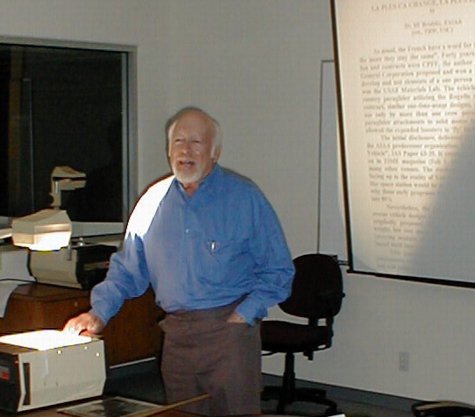Search this Site







Editor: Kris Cerone
"The Space Station Needs A Lifeboat!"
Says OASIS Speaker
By Steve Bartlett
Dr. Robert Brodsky, retired professor from USC and aerospace engineer, proclaimed the dire need for new and innovative space rescue vehicles in a lecture to space enthusiasts on February 15.
The Space Station is like an ocean liner,
stated Brodsky. It carries people across long distances, far from immediate help. And, like an ocean liner, it needs a lifeboat.
He described his work in the early 1960's and subsequently to develop lightweight, inflatable paragliders (a combination of glider and parachute) able to carry from one to several crewmembers from a crippled pacecraft. Working for Space General Corporation, Brodsky and his team designed and built test hardware showing the concept's viability. Their approach featured a three-foot diameter, ten-foot long cylinder that could quickly deploy into a large paraglider. The vehicle would have been capable of sustaining a crew member for up to five hours and safely returning him to Earth.
 |
| Dr. Robert Brodsky. Photo courtesy Kat Tanaka. |
Working under a $1.6 million Air Force contract to support the Manned Orbiting Lab (MOL) program, the team's efforts garnered the attention of the popular media, including Time and Aviation Week magazines and the Los Angeles Times.
The rescue craft would have used woven metal fabric with alternating layers of thermal insulation.The approach resulted in a large surface area and substantial aerodynamic drag. This would allow the craft to gently bring the crew member home. Brodsky described how the concept could be easily scaled-up, accommodating a seven-person crew in a craft that weighed less than 2000 pounds.The Space General group performed numerous strength and temperature tests on their materials to show that they could withstand reentry conditions. Another concept put forth at the time by Douglas Aircraft Company featured a lightweight deployable structure that looked like an inverted parachute.
NASA rejected these concepts and chose to pursue lifting bodies for crew rescue vehicles, culminating in work on the HL-20 and the X-38. "NASA got a Not Invented Here mindset and refused to look at any other approach," said Brodsky. He wrote multiple letters to NASA and the popular press complaining about the cost and complexity of the lifting body concept and the way that NASA chose to implement it.
They were looking for a Shuttle replacement with the X-38, not a crew rescue vehicle,
Brodsky commented. In his view, the high development cost identified by NASA for their vehicle ensured that it would be cancelled, thus leaving the Space Station with limited crew return capability.
The Alpha Space Station currently uses Russian-built Soyuz capsules for crew return. This ensures that the current crewcan return to Earth in the event of an emergency. Unfortunately, the Soyuz can hold only three crew members and the Russian space agency has insufficient funds to keep the production line open. Because U.S. federal law prevents NASA from directly transferring funds to the Russians, NASA cannot pay to keep line running. This situation and the recent Columbia shuttle accident have put the future of the facility is at risk. Brodsky believes that the problem could be easily solved with a few low cost lifeboats. He suggests that NASA should develop and test several concepts, each with a good chance of success for safe crew return. A lifeboat on an ocean liner doesn't guarantee survival,
said Brodsky. But it does give the crew and passengers a fair chance of it. A Station rescue vehicle should do the same.
Copyright © 1998-2003 Organization for the Advancement of Space Industrialization and Settlement. All Rights Reserved.